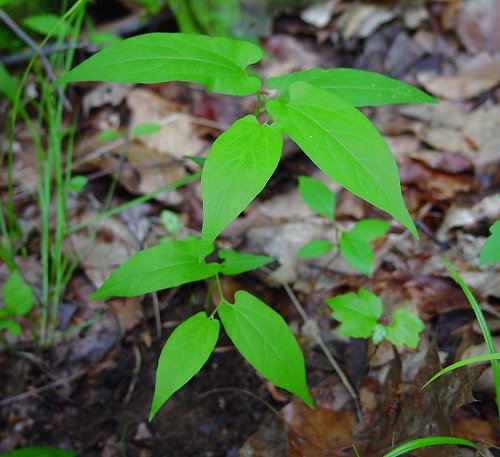Endodeca serpentaria (L.) Raf.
Virginia Snakeroot

Native
CC = 6
CW = 5
MOC = 66
© DETenaglia
Endodeca serpentaria (L.) Raf.Virginia Snakeroot | |
 |
Native CC = 6 CW = 5 MOC = 66 |
© DETenaglia |
|
Family - Aristolochiaceae Habit - Rhizomatous perennial forb. Stems - Ascending, to 60 cm, usually appearing zigzag, glabrous or hairy. Leaves - Alternate, petiolate, simple, entire. Petioles to 3.5 cm. Leaf blades 5-14 cm long, lanceolate to oblong-ovate or narrowly triangular, sharply pointed, cordate or arrowhead-shaped at the base, the main veins pinnate above a somewhat palmate base, the undersurface sometimes hairy.
Inflorescence - Flowers solitary at the tips of short, scaly stalks produced near the base of the aerial stem, often submerged beneath a thin layer of soil or leaf detritus. Flowers - Zygomorphic with a well-developed calyx tube, this 1-3 cm long, hairy, hooked or S-shaped, expanded at both ends, purple to brown above a white to tan base, the lobes ascending to spreading, unequal, shallow, broadly triangular, purple and glabrous on the inner (upper) surface. Stamens 6, the filaments fused with the style into a column. Ovary with 3 locules. Stigmas appearing as a low, irregular, 3-lobed crown at the tip of the stylar column.
Fruits - Capsules 0.8-1.8 cm long, globose, 6-ribbed, dehiscing longitudinally. Seeds 4-5 mm long, concave and with a longitudinal ridge on one side, rounded on the other, ovate in outline, brown, with a lighter pattern of wrinkled ridges and finely pebbled bumps.
Flowering - May - July. Habitat - Rich or rocky woods, thickets, ravines, slopes. Origin - Native to the U.S. Other info. - This small species can be found throughout south and central Missouri, but is apparently absent from the northwestern third of the state. It is common throughout most of the eastern U.S. The plant is often overlooked because it grows low to the ground and the flowers are rarely seen except by deliberate, close examination. Careful removal of the leaf litter around the base of the plant will reveal the interesting flowers. Photographs taken in Brown Summit, NC., 5-18-02 (DETenaglia); also at Matson Hill County Park, St. Charles County, MO, 10-04-2016, and St. Joe State Park, St. Francois County, MO, 05-15-2017 (SRTurner); also at St. Francois State Park, St. Francois County, MO, 7-20-2023 (KBildner). |